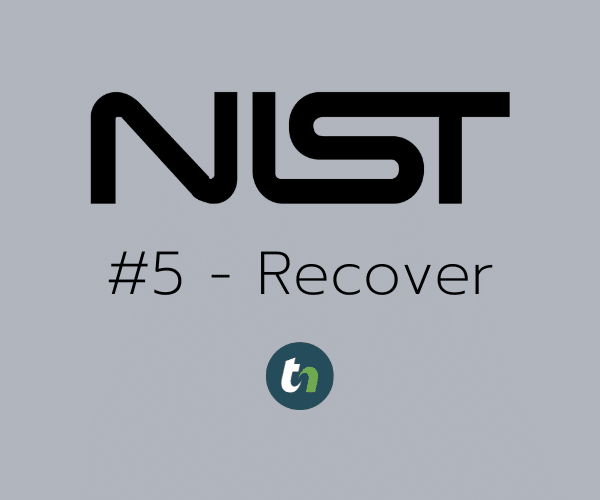In our last, but no less important article around the five pillars associated with the National Institutes of Standards and Technology’s (NIST) Cybersecurity Framework (CSF), we discuss the Recover pillar.
If you have properly addressed the other four pillars associated with the NIST Cybersecurity Framework, the Recover pillar should be a consequence of what you have already done. However, if you have not taken the appropriate measures to identify your assets your ability to recover may be limited.
This is why no single pillar alone will address your needs entirely since they all work in concert to ensure complete network protection while making certain you have documented processes to recover.

Overview of the NIST Cybersecurity Framework Pillars
- Identify: Develops an organizational understanding to manage cybersecurity risk to systems, people, assets, data, and capabilities.
- Protect: Develops and implements appropriate safeguards to ensure the delivery of critical infrastructure services.
- Detect: Develops and implements appropriate activities to identify the occurrence of a cybersecurity event.
- Respond: Develops and implements appropriate activities to take action regarding a detected cybersecurity event.
- Recover: Develops and implements appropriate activities to maintain plans for resilience and restore any capabilities or services impaired due to a cybersecurity event.
The Recover Pillar: In-Depth
The Recover pillar focuses on maintaining resilience and restoring any capabilities or services that were impaired due to a cybersecurity incident. This pillar is crucial for ensuring that organizations can quickly return to normal operations after an incident. The Recover function is broken down into several key categories:
#1 – Recovery Planning
Description: Developing and implementing recovery processes and procedures to restore systems and assets affected by cybersecurity incidents.
This requires a complete understanding of your network environment and those areas that are mission critical to the organization as you will want to rank these by importance when assembling a recovery plan – i.e. having your cameras and card access systems online first to ensure entry to the building followed by restoring the ERP solution.
Significance: Having a well-defined recovery plan ensures that organizations can quickly restore critical functions and minimize downtime after an incident.
#2 – Improvements
Description: Implementing measures to improve recovery planning and processes based on lessons learned from past incidents and continuous improvement efforts
This is why it is important to test this process at least once a year to ensure you are improving or that you address any areas that may have changed within the company. Examples might include updating your contact list when someone leaves the organization or updating your list of priority applications if you make a change in ERP or CRM providers.
Significance: Continuous improvement helps organizations enhance their resilience and better prepare for future incidents resulting in an improved time to recovery.
#3 – Communications
Description: Coordinating recovery efforts with internal and external stakeholders to ensure timely and effective communication during and after a cybersecurity incident
We have seen a number of organizations impacted more than they should have been simply due to not having an updated contact list.
Significance: Clear communication is essential for managing stakeholder expectations, providing updates on recovery progress, and maintaining trust.
What the Recover Pillar Means in the NIST Cybersecurity Framework
The Recover pillar is vital for an organization’s ability to bounce back from cybersecurity incidents. Here’s what it entails:
- Developing a Recovery Plan: Organizations must have a comprehensive recovery plan that outlines the steps to restore systems and services after an incident. This plan should include detailed procedures for different types of incidents, ensuring that the organization can respond effectively regardless of the nature of the threat.
- Implementing Continuous Improvements: Recovery processes should not be static. Organizations need to continually assess and improve their recovery strategies based on lessons learned from past incidents and emerging best practices. This iterative process helps build resilience and adaptability.
- Ensuring Effective Communication: During and after an incident, timely and clear communication with stakeholders is crucial. This includes updating internal teams, clients, regulators, and other relevant parties about the status of recovery efforts. Effective communication helps manage expectations and maintain trust.
This concludes our series on the NIST Cybersecurity Framework; however, we will also be discussing the upcoming sixth pillar which is being introduced soon. This is known as the Govern pillar and was developed for use by critical infrastructure organizations such as banks, utilities and even some small to medium sized local businesses – depending on the nature of their business.
Govern: Establish and monitor the organization’s cybersecurity risk management strategy, expectations and policy
The reason for adding this pillar is to not only provide additional guidelines but also to remind organizations that cyber attacks are a major source of enterprise risk and should be an ongoing consideration for senior leadership within an organization – not just those where compliance is formally required.
If you would like more information on how ThrottleNet meets the NIST Cybersecurity Framework or if you would like an assessment to see how your organization aligns with NIST currently, please feel free to reach out us.

Chris Montgomery
ThrottleNet Sales Director
cmontgomery@throttlenet.com



